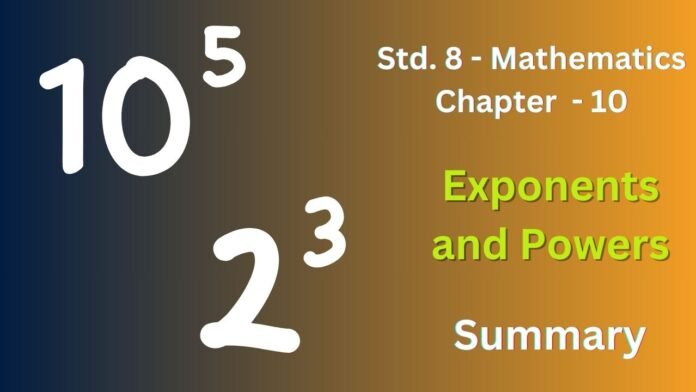Exponents are a shorthand way of representing repeated multiplication.
- Base: The number being multiplied repeatedly.
- Exponent (or power): The number of times the base is multiplied by itself.
For example, in 2³, 2 is the base and 3 is the exponent. This means 2 multiplied by itself 3 times (2 × 2 × 2).
Key Concepts:
- Laws of Exponents: These rules simplify calculations involving exponents.
- a^m × a^n = a^(m+n)
- a^m / a^n = a^(m-n)
- (a^m)^n = a^(mn)
- a^0 = 1
- a^-m = 1/a^m
- Standard Form: Expressing very large or very small numbers in a compact form using exponents.
- Applications: Exponents are used in various fields like science, engineering, and finance for representing large and small quantities.
By understanding exponents, you can efficiently handle calculations involving large numbers and simplify complex expressions.
Exercise 10.1
1. Evaluate:
(i) 3-2
(ii) -4-2
(iii) (1/2)-5
Ans :
(i) 3^-2
- This is equal to 1 / 3².
- Therefore, 3^-2 = 1/9.
(ii) (-4)^-2
- This is equal to 1 / (-4)².
- Since (-4)² = 16, (-4)^-2 = 1/16.
(iii) (1/2)^-5
- Using the rule (a/b)^-n = (b/a)^n, we get:
- (1/2)^-5 = (2/1)^5 = 2^5 = 32.
2. Simplify and express the result in power notation with a positive exponent.
Ans :
(i) (-4)^5 ÷ (-4)^8
= (-4)^(5-8) // Using the division law
= (-4)^(-3)
= 1 / (-4)^3
(ii) ((1/2)^3)^2
= (1/2)^(3*2) // Using the power of a power law
= (1/2)^6
(iii) (-3)^4 * (5/3)^4
= ((-3)*5/3)^4 // Using the power of a product law
= (-5)^4
(iv) (3^-7 + 3^-10) * 3^-5
= 3^(-7-5) + 3^(-10-5) // Using the product law
= 3^-12 + 3^-15
(v) 2^-3 * (-7)^-3
= 1/(2^3 * (-7)^3) // Using the negative exponent rule
= 1/(-14)^3
3. Find the value of
Ans :
Let’s evaluate each expression:
(i) (3⁰ + 4⁻¹) * 2²
- We know that any number raised to the power of 0 is 1, and a negative exponent means the reciprocal.
- So, (3⁰ + 4⁻¹) * 2² = (1 + 1/4) * 4 = (5/4) * 4 = 5
(ii) (2⁻¹ * 4⁻¹) ÷ 2⁻²
(2⁻¹ * 4⁻¹) ÷ 2⁻² = (2⁻¹ * 2⁻²) / 2⁻² = 2⁻¹ = 1/2
(iii) (1/2)⁻² + (1/3)⁻² + (1/4)⁻²
- Using the property (a/b)⁻ⁿ = (b/a)^n, we get:
- (2)² + (3)² + (4)² = 4 + 9 + 16 = 29
(iv) (3⁻¹ + 4⁻¹ + 5⁻¹)^0
- Any non-zero number raised to the power of 0 is 1.
- (3⁻¹ + 4⁻¹ + 5⁻¹)^0 = 1
(v) [{(-2)/3}⁻²]²
- Using the property (a^m)^n = a^(mn), we get:
- [(-2)/3]⁻² * ² = [(-2)/3]⁻⁴
- Using the property a⁻ⁿ = 1/aⁿ, we get:
- [(-2)/3]⁻⁴ = (3/-2)⁴ = 81/16
4. Evaluate
Ans :
Expression (i):
- (8^-1 * 5^3) / 2^-4
Using the law of exponents: a^-m = 1/a^m, we get:
- (1/8 * 125) / (1/16)
- (125/8) * 16
- 250
Expression (ii):
- (5^-1 * 2^-1) * 6^-1
Using the law of exponents: a^-m * b^-n = 1/(a^m * b^n), we get:
- 1/(526)
- 1/60
5. Find the value of m for which 5m/53= 55
Ans :
Solution
- Given equation: 5^m / 5^3 = 5^5
- Using the division law of exponents: a^m / a^n = a^(m-n)
- 5^(m-3) = 5^5 (bases are the same (5))
- m – 3 = 5
- Solving for m:
- m = 5 + 3
- m = 8
Therefore, the value of m is 8.
6. Evaluate:
Ans :
(i) Evaluating the expression:
[((1/3)^(-1)) – ((1/4)^(-1))]^(-1)
Step-by-step solution:
Simplify the inner terms using the rule (a^-1) = 1/a:
[(3) – (4)]^(-1)
Perform the subtraction:
(-1)^(-1)
Use the rule (a^-1) = 1/a: -1
Therefore, the value of the expression is -1.
(ii) Evaluating the expression:
(5/8)^(-7) * (8/5)^(-4)
Step-by-step solution:
Use the rule (a/b)^(-n) = (b/a)^n:
(8/5)^7 * (5/8)^4
Use the rule (a^m) * (a^n) = a^(m+n):
(8/5)^(7-4)
Simplify the exponent:
(8/5)^3
7. Simplify:
Ans :
Exercise 10.2
1. Express the following numbers in standard form:
(i) 0.0000000000085
(ii) 0.00000000000942
(iii) 6020000000000000
(iv) 0.00000000837
(v) 31860000000
Ans :
(i) 8.5 × 10^-12
(ii) 9.42 × 10^-12
(iii) 6.02 × 10^15
(iv) 8.37 × 10^-9
(v) 3.186 × 10^10
2. Express the following numbers in usual form.
(i) 3.02 × 10-6
(ii) 4.5 × 104
(iii) 3 × 10-8
(iv) 1.0001 × 109
(v) 5.8 × 1012
(vi) 3.61492 × 106
Ans :
(i) 0.00000302
(ii) 45000
(iii) 0.00000003
(iv) 1000100000
(v) 5800000000000
(vi) 3614920
3. Express the number appearing in the following statements in standard form.
(i) 1 micron is equal to 1/1000000 m.
(ii) Charge of an electron is 0.000,000,000,000,000,000,16 coulomb
(iii) Size of a bacteria is 0.0000005 m
(iv) Size of a plant cell is 0.00001275 m
(v) Thickness of a thick paper is 0.07 mm.
Ans :
(i) 1 × 10^-6 m
(ii) 1.6 × 10^-19 coulomb
(iii) 5 × 10^-7 m
(iv) 1.275 × 10^-5 m
(v) 7 × 10^-5 m
4. In a stack there are 5 books each of thickness 20 mm and 5 paper sheets each of thickness 0.016 mm. What is the total thickness of the stack?
Ans :
- Thickness of 5 books: 5 books * 20 mm/book = 100 mm
- Thickness of 5 paper sheets: 5 sheets * 0.016 mm/sheet = 0.08 mm
- Total thickness of the stack: 100 mm + 0.08 mm = 100.08 mm
Therefore, the total thickness of the stack is 100.08 mm.


